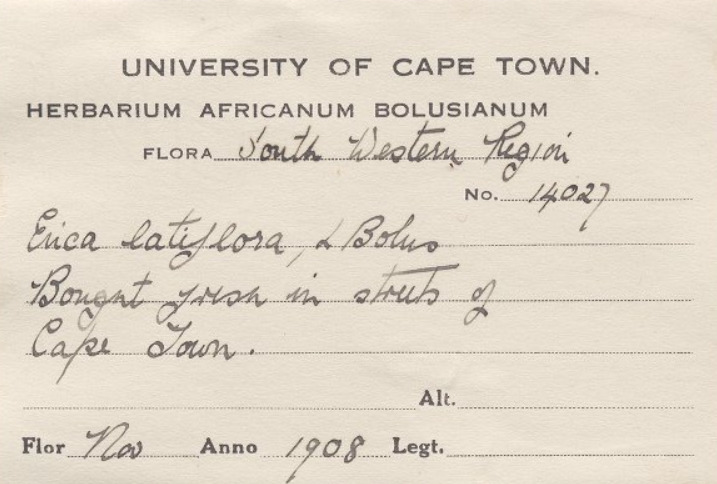"Bought fresh in streets of Cape Town"
Item
Title
"Bought fresh in streets of Cape Town"
Is Part Of
Biological Sciences
See all items with this value
African Studies
See all items with this value
Gender Studies
See all items with this value
History
See all items with this value
Description
"The flower sellers trading in Trafalgar Place and along Adderley Street have been doing so since at least the mid-1880s but became viewed as threats to the local flora by the European settlers at about the same time the medicine chest was first introduced to the city at the beginning of the 20th century. The settlers initially preferred to cultivate plants imported from their home countries to indigenous varieties, introducing many species to South Africa for nostalgic or practical reasons (subsequently problematic for local biodiversity) (Van Sittert 2002: 103). In the wake of the emerging nationalism of the white settlers in the 1890s, interest in indigenous plants gained momentum and was deployed to create a sense of belonging to the ‘foreign’ land (Boehi 2013: 133). A botanical discourse was mobilised to underscore ideas about identity and belonging, such as ‘roots’ and ‘ideas of rootedness’, and laws regulating flower picking (which usually occurred on the mountain) were passed in this period and were secured by the Wild Flower Protections Act in 1905 and an amendment thereto in 1908 (Boehi 2013: 133)" (Liebenberg 2021: 275).
This is a label on a botanical specimen (K000225239) found in the Royal Botanic Gardens of Kew that was donated to the Gardens by UCT. Described in pen in the notes section, the specimen is of the local Erica latiflora and was collected in 1908, when it was ‘bought fresh in the streets of Cape Town’. The insider details noted on this specimen reveal much to outsiders such as Boehi (2013) and Van Sittert (2010) – scholars who have written about the colonial history of botany in the Cape and the unofficial presence of the flower sellers in the provenance of many specimens from the Cape kept in international herbaria.
This is a label on a botanical specimen (K000225239) found in the Royal Botanic Gardens of Kew that was donated to the Gardens by UCT. Described in pen in the notes section, the specimen is of the local Erica latiflora and was collected in 1908, when it was ‘bought fresh in the streets of Cape Town’. The insider details noted on this specimen reveal much to outsiders such as Boehi (2013) and Van Sittert (2010) – scholars who have written about the colonial history of botany in the Cape and the unofficial presence of the flower sellers in the provenance of many specimens from the Cape kept in international herbaria.
Creator
Nina Liebenberg
See all items with this value
Date Created
2021
Source
Liebenberg, N. 2021. The virus and the vaccine: curatorship and the disciplinary outsider. University of Cape Town. Doctoral dissertation.
Resonances
Adderley Street flower sellers
See all items with this value
Lance von Sittert
See all items with this value
Melani Boehi
See all items with this value
Kew Gardens
See all items with this value
Bolus Herbarium
See all items with this value
classification
See all items with this value
taxonomies
See all items with this value
absence
See all items with this value
invisible
See all items with this value
colour chart
See all items with this value
Carl Linnaeus
See all items with this value
medicine chest
See all items with this value
Chest: a botanical ecology
See all items with this value
Type
Specimen




